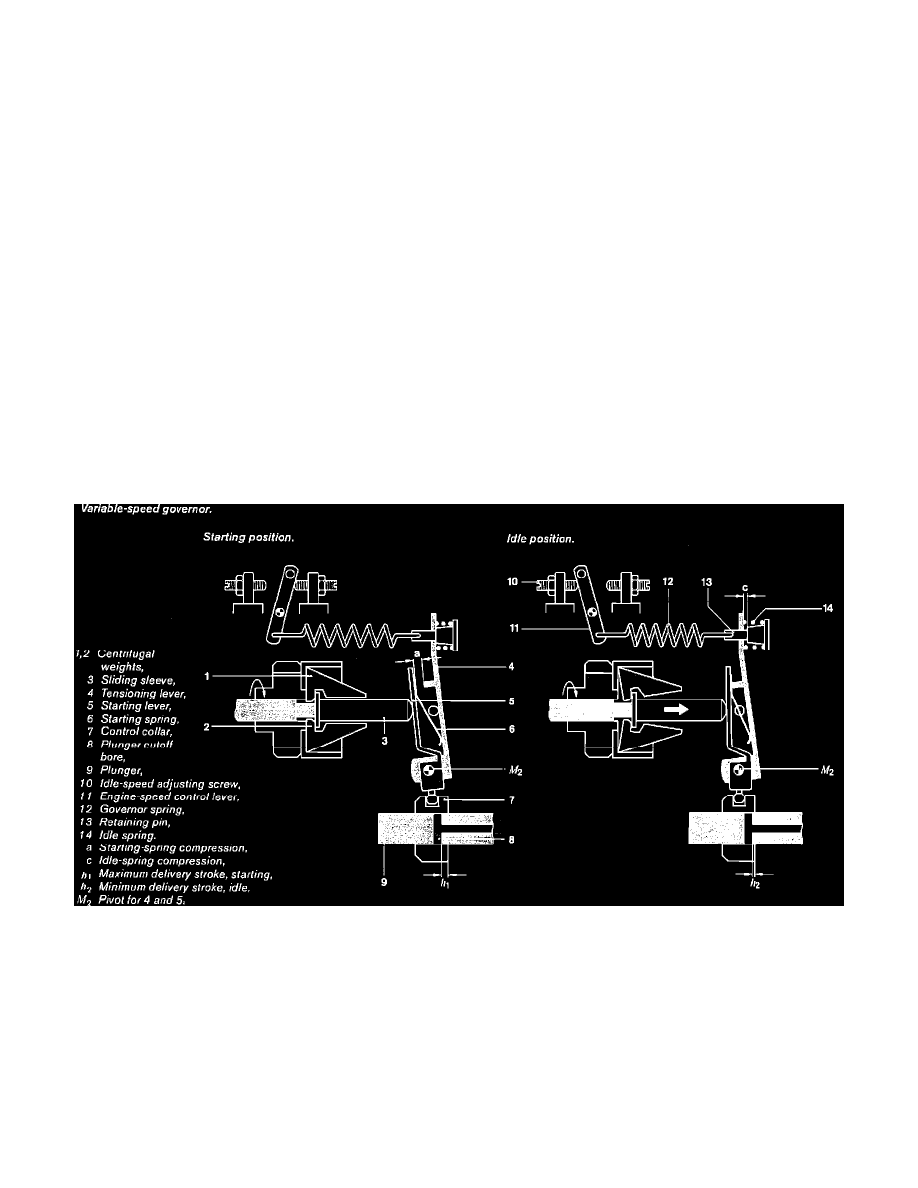Vanagon L4-1588cc 1.6L DSL SOHC (1983)

movement stretches the governor spring by a certain amount, with the result that spring force now exceeds that of the centrifugal weights.
Governor-spring tension pulls the starting and tensioning levers, which pivot around point M2, Fig. 9, and move the control collar (according to the
linkage geometry) into a position that increases fuel delivery. Increased engine speed is the result. The centrifugal weights then swing outward due to the
increased speed, and move the sliding sleeve in opposition to the governor-spring tension. The control collar, however, remains in its "full" position until
balance is attained. If engine speed continues to increase, the weights swing farther outward and sleeve force becomes dominant. Now the starting and
tensioning levers pivot around M2, moving the control collar in its 'stop' direction so that the cutoff bore is opened earlier. Delivery can be reduced all
the way to minimum in this process, which puts a cap on engine speed. For each position of the engine speed control lever, therefore, there is a precise
engine-speed range between full load and no load, as long as the engine is not overloaded. The result is that the governor, working within the parameter
of its speed droop, maintains the engine speed dictated by the accelerator pedal.
Should load increase to the point where the collar is in its full-load position but engine speed continues to fall, as when the vehicle is pulling a grade,
the weights swing inward. But because the collar is already at its position of maximum delivery, fuel delivery cannot be increased further. The engine is
thus overloaded and the driver must either downshift or ease off on the accelerator.
Speed Control Accuracy
The basic parameter for a governor's accuracy in controlling engine speed is the so-called speed droop. This is the percentage of engine-speed increase
that occurs when loading is removed from a Diesel engine with no change in control-lever (accelerator) position. Within the control range, this speed
increase may not exceed a certain value. The controlled upper speed limit is the absolute maximum value and occurs when the engine, starting at its
maximum full-load speed, is relieved of all loading. Engine-speed increase is proportional to the change in load; the greater the load change, the greater
the increase in engine speed.
The desirable speed droop depends upon engine application. For an engine powering an electrical generator, for instance, a small droop is required so
that load changes result in minimal speed change. For motor vehicles, a large speed-droop value is better because it results in more stable speed control
when small load changes take place (such as on acceleration or deceleration) and therefore better driveability. A small speed droop would give jerky
operation during load changes.
Starting
Fig. 8 Variable Speed Governer
With the engine stationary the centrifugal weights and sliding sleeve are in their initial position, Fig. 8. The starting lever is moved to the starting
position by its spring and pivots around the point M2; at the same time the control collar on the distributor plunger is held in its starting position by the
ball pin of the starting lever. This set of conditions means that the plunger has a large stroke (maximum delivery = starting delivery) before delivery
ends.
Thus the starting-fuel delivery is determined. Once starting begins, it takes only a modest rotational speed - the cranking speed - to affect the
centrifugal weights and move the sliding sleeve against its weak spring the distance a. The starting lever again pivots around M2, reducing delivery
automatically to the idle level.
Function
In the injection process, the injection nozzle is opened by a pressure wave that propagates through the injection line at sound velocity. The time it
